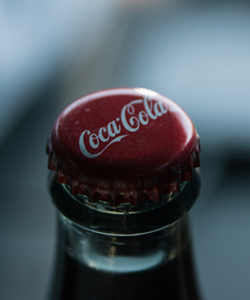
Although branding is a word often used in marketing, its meaning has changed over time. Initially, it was used by cattle ranchers to identify their cattle.
Later, it was somewhat synonymous with “trademark,” a label to inform a consumer about the manufacturer of a product. For instance, Coca-Cola is a carbonated beverage made by the Coca-Cola Company.
In today’s world, branding has acquired an even more subtle meaning: it’s a way of influencing perception. For instance, Coca-Cola is not just the name of a soda. It’s a carbonated beverage that offers the distinct flavor and taste of a secret formula patented by the Coca-Cola Company. A branded name is now associated with the unique qualities of a product.
Once you understand that branding is linked to consumer perception, one shaped through public relation and advertising campaigns, it becomes clear why maintaining brand consistency, especially for companies just starting out.
Without a brand name, you risk confusing your product with other similar, generic products. Consequently, your company name, brand color scheme, logo design, etc should be the same across all sales platforms, advertising, and promotions. For example, if you’re at a trade show, your POP displays, point of purchase display signs, should be in harmony with existing brand graphics and imagery. Branding consistency will help consumers quickly identify your business and product line.
Think of a Brand as an Asset
An asset is something that is useful and offers value, often monetary value.In that sense, a brand is an asset.
Since consumer view one more brand favorably than other producers in an industry, they are more likely to buy their products over and over again. For instance, people who favor the Apple brand are convinced that its technology is superior to all other computer manufacturers. According to Wired, however, Apple gained marketing traction because of its superb marketing: “Sculley marketed Apple like crazy, boosting the advertising budget from $15 million to $100 million.”
Although perception is intangible, it can be your business’s most important asset. If you make a distinctly superior product, name recognition will help you differentiate your product from everything else available in your niche.
Branding creates a sense of connection between your company and a customer. People who like your brand will consistently purchase your product and recommend it to others. In return, your business will have an to identify the demographics and psychographics of people who like your product. Understanding your audience’s preferences makes it easier to get feedback on what improvements to make and what new products to roll out.
Why Stay Consistent
Although your organization may still maintain the same core values and mission purpose, as well as continue to produce high-quality products, inconsistency with branding will weaken its image. Once you’ve developed a strong brand, you have to be consistent—otherwise, you’ll begin to lose market share.
2 Big Branding Mistakes to Avoid
When companies are inconsistent about their branding, particularly one that they’ve spent a long time developing, it’s usually because they either change their business name or their branding elements.
- Changing a business name: Once you’ve found the perfect name for your business and begun to develop your brand avoid changing the name because you’ve discovered an even better name. Resist this creative impulse because it comes with certain attendant risks: loss of established marketing equity, consumer confusion, and high expenses to advertise the name change. Sometimes a name change may be warranted if a company wants to change its business model, enter a new market, or because of an acquisition or merger. However, unless, there are strong reasons for changing a name, it’s not a good idea.
- Changing branding elements: When a company becomes national or international, it has to clearly communicate its various branding elements to all its branch offices so that they can be accurately replicated in all marketing materials. If it fails to do this, then creative ideas and cultural influence will make it difficult for consumers to recognize the original brand.
In the final analysis, without a brand, it’s difficult to differentiate your product from other similar products; however, with a strong brand, you’ll be able to get your share of a marketplace and build a large following of brand enthusiasts over time.







Discussion